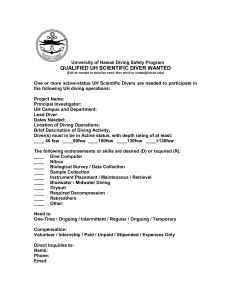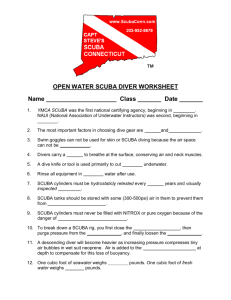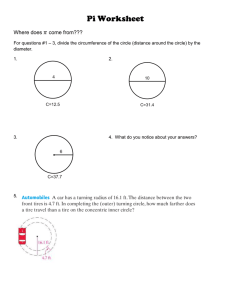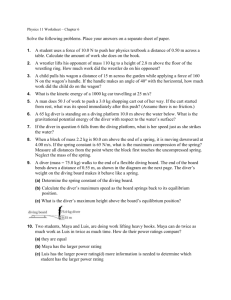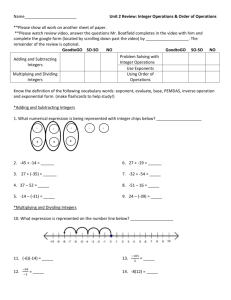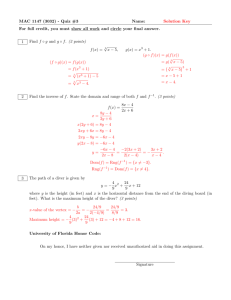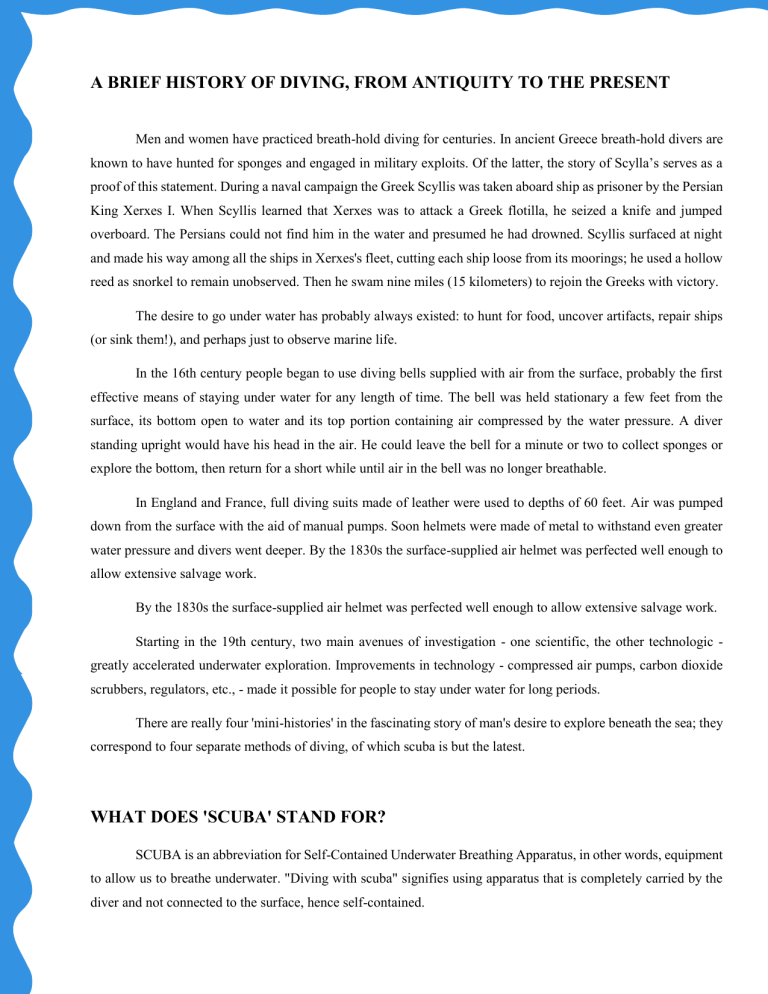
A BRIEF HISTORY OF DIVING, FROM ANTIQUITY TO THE PRESENT Men and women have practiced breath-hold diving for centuries. In ancient Greece breath-hold divers are known to have hunted for sponges and engaged in military exploits. Of the latter, the story of Scylla’s serves as a proof of this statement. During a naval campaign the Greek Scyllis was taken aboard ship as prisoner by the Persian King Xerxes I. When Scyllis learned that Xerxes was to attack a Greek flotilla, he seized a knife and jumped overboard. The Persians could not find him in the water and presumed he had drowned. Scyllis surfaced at night and made his way among all the ships in Xerxes's fleet, cutting each ship loose from its moorings; he used a hollow reed as snorkel to remain unobserved. Then he swam nine miles (15 kilometers) to rejoin the Greeks with victory. The desire to go under water has probably always existed: to hunt for food, uncover artifacts, repair ships (or sink them!), and perhaps just to observe marine life. In the 16th century people began to use diving bells supplied with air from the surface, probably the first effective means of staying under water for any length of time. The bell was held stationary a few feet from the surface, its bottom open to water and its top portion containing air compressed by the water pressure. A diver standing upright would have his head in the air. He could leave the bell for a minute or two to collect sponges or explore the bottom, then return for a short while until air in the bell was no longer breathable. In England and France, full diving suits made of leather were used to depths of 60 feet. Air was pumped down from the surface with the aid of manual pumps. Soon helmets were made of metal to withstand even greater water pressure and divers went deeper. By the 1830s the surface-supplied air helmet was perfected well enough to allow extensive salvage work. By the 1830s the surface-supplied air helmet was perfected well enough to allow extensive salvage work. Starting in the 19th century, two main avenues of investigation - one scientific, the other technologic greatly accelerated underwater exploration. Improvements in technology - compressed air pumps, carbon dioxide scrubbers, regulators, etc., - made it possible for people to stay under water for long periods. There are really four 'mini-histories' in the fascinating story of man's desire to explore beneath the sea; they correspond to four separate methods of diving, of which scuba is but the latest. WHAT DOES 'SCUBA' STAND FOR? SCUBA is an abbreviation for Self-Contained Underwater Breathing Apparatus, in other words, equipment to allow us to breathe underwater. "Diving with scuba" signifies using apparatus that is completely carried by the diver and not connected to the surface, hence self-contained. The air that is in the tanks is compressed air as we know it outside, so parts nitrogen, parts oxygen, and some other gases as well. Because of the nitrogen in the compressed air, divers need to be very careful when diving to greater depths, as nitrogen narcosis can occur, which has the same effect as excessive alcohol. HOW POPULAR IS SCUBA DIVING? An estimated 2.5-3.5 million Americans participate in recreational scuba diving. Another 500 thousand become certified each year in the United States. In the early days of scuba diving (roughly 1950-1970), participants were predominately young men. Today the sport is enjoyed by people in all age groups and both sexes. And why not? Just about any teenager or adult who enjoys the water and can swim, and who does not have heart or lung impairment, can learn to scuba dive. It does not take great physical strength or unusual exercise tolerance. All it takes is the desire, plus some basic classroom and in-water training. Scuba originally began with military and commercial applications, where it is still employed. However, by far its widest use, in terms of number of participants, is recreational. Recreational scuba today is like other any other sport that requires specialized equipment and training, such as snow skiing, sailing, mountain climbing and horseback riding. This section will provide an overview of recreational scuba diving, and explain how it differs from other forms of diving with scuba equipment. WHAT ARE THE EQUIPMENTS IN SCUBA? Finding the right diving equipment and scuba diving gear is essential to having a good and safe diving experience. Whether you’re a beginner scuba diver or an experienced diver, everyone needs to have the same high quality equipment and the knowledge about how to use it properly. 1.0 EQUIPMENTS FOR NAVY USE Open-Circuit Scuba. All open-circuit scuba authorized for Navy use employ ademand system that supplies air each time the diver inhales. The basic open-circuitscuba components are: Demand regulator assembly, One or more air cylinders, Cylinder valve and manifold assembly, Backpack or harness 1.1 The Demand Regulator Assembly It is the central component of the open-circuit system. The regulator delivers air to the diver after reducing the high-pressure air in the cylinder to a pressure that can be used by the diver. 1.2 Cylinders. Scuba cylinders (tanks or bottles) are designed to hold high pressure compressed air. Because of the extreme stresses imposed on a cylinder at these pressures, all cylinders used in scuba diving must be inspected and tested periodically. Approved scuba cylinders are available in several sizes and one or two cylinders may be worn to provide the required quantity of air for the dive. The volume of a cylinder, expressed in actual cubic feet or cubic inches, is a measurement of the internal volume of the cylinder. The capacity of a cylinder, expressed in standard cubic feet or liters, is the amount of gas (measured at surface conditions) that the cylinder holds when charged to its rated pressure. 1.3 Cylinder Valves and Manifold Assemblies. Cylinder valves and manifolds makeup the system that passes the high-pressure air from the cylinders to the first-stage regulator. The cylinder valve serves as an on/off valve and is sealed to the tank by a straight-threaded male connection containing a neoprene O-ring on the valve’s body 1.4 Backpack or Harness. A variety of backpacks or harnesses, used for holding the scuba on the diver’s back, have been approved for Navy use. The backpack may include a lightweight frame with the cylinder(s) held in place with clamps or straps. The usual system for securing the cylinder to the diver uses shoulder and waist straps. All straps must have a quick-release feature, easily operated by either hand, so that the diver can remove the cylinder and leave it behind in an emergency. 2.0 MINIMUM EQUIPMENTS 2.1 Face Mask or Diving Mask Human eyes were not designed to work well under water—particularly saltwater. Therefore, one of the most important things you will need is a diving mask. The face mask protects the diver’s eyes and nose from the water. Additionally, it provides maximum visibility by putting a layer of air between the diver’s eyes and the water. Face masks are available in a variety of shapes and sizes for diver comfort. To check for proper fit, hold the mask in place with one hand and inhale gently through the nose. The suction produced should hold the mask in place. Don the mask with the head strap properly adjusted, and inhale gently through the nose. If the mask seals, it should provide a good seal in the water. Some masks are equipped with a one-way purge valve to aid in clearing the mask of water. Some masks have indentations at the nose or a neoprene nose pad to allow the diver to block the nostrils to equalize the pressure in the ears and sinuses. Several models are available for divers who wear eyeglasses. 2.2 Life Preserver or SCUBA Diving Vest The principal functions of the life preserver are to assist a diver in rising to the surface in an emergency and to keep the diver on the surface in face-up position (Figure below). The low-pressure inflation device on the preserver maybe actuated by the diver, or by a dive partner should the diver be unconscious or otherwise incapacitated. In selecting a life preserver for a specific task, the individual technical manuals should be consulted. The use of certain closed and semi-closed UBAs will require the wearing of a life preserver. The life preserver must be sturdy enough to resist normal wear and tear, and of sufficient volume to raise an unconscious diver safely from maximum dive depth to the surface. Most life preservers currently in use employ carbon dioxide (CO2) cartridges to provide inflation in an emergency. 2.3 Buoyancy Compensator When a life preserver is not required by a specific UBA, a buoyancy compensator may be used at the Diving Supervisor’s discretion. When selecting a buoyancy compensator, a number of factors must be considered. These factors include: type of wet suit, diving depth, breathing equipment characteristics, nature of diving activity, accessory equipment, and weight belt. As a buoyancy compensating device, the compensator can be inflated by a low-pressure inflator connected to the first-stage regulator, or an oral inflation tube. The compensator is used in conjunction with the diver weights to control buoyancy in the water column by allowing the diver to increase displacement through inflation of the device, or to decrease displacement by venting. 2.4 Weight Belt. Scuba is designed to have nearly neutral buoyancy. With full tanks, a unit tends to have negative buoyancy, becoming slightly positive as the air supply is consumed. Most divers are positively buoyant and need to add extra weight to achieve a neutral or slightly negative status. This extra weight is furnished by a weighted belt worn outside of all other equipment and strapped so that it can easily released in the event of an emergency. Each diver may select the style and size of belt and weights that best suit the diver. A number of different models are available. A weight belt shall meet certain basic standards: the buckle must have a quick-release feature, easily operated by either hand; the weights (normally made of lead) should have smooth edges so as not to chafe the diver’s skin or damage any protective clothing, and the belt should be made of rot- and mildewresistant fabric, such as nylon webbing. 2.5 Knife Several types of knives are available. Diving knives should have corrosion-resistant blades and a handle of plastic, hard rubber, or wood. Handles made of wood should be waterproofed with paint, wax, or linseed oil. Handles of cork or bone should be avoided, as these materials deteriorate rapidly when subjected to constant saltwater immersion. Cork may also float the knife away from the diver. Knives may have single- or double-edged blades with chisel or pointed tips. The most useful knife has one sharp edge and one saw-toothed edge. All knives must be kept sharp. The knife must be carried in a suitable scabbard and worn on the diver’s life preserver, hip, thigh, or calf. The knife must be readily accessible in terms of danger, must not interfere with body movement, and must be positioned so that it will not become fouled while swimming or working. The scabbard should hold the knife with a positive but easily released lock. 2.6 Swim Fins. Swim fins increase the efficiency of the diver, permitting faster swimming over longer ranges with less expenditure of energy. Swim fins are made of a variety of materials and styles. Each feature—flexibility, blade size, and configuration—contributes to the relative power of the fin. A large blade will transmit more power from the legs to the water, provided the legs are strong enough to use a larger blade. Small or soft blades should be avoided. Ultimately, selection of blade type is a matter of personal preference based on the diver’s strength and experience. 2.7 Wrist Watch. Analog diver’s watches must be waterproof, pressure proof and, equipped with a rotating bezel outside the dial that can be set to indicate thee lapsed time of a dive. A luminous dial with large numerals is also necessary. Additional features such as automatic winding, nonmagnetic components, and stop watch action are available. Digital watches, with a stop watch feature to indicate the elapsed time of a dive, are also approved for Navy use. 2.8 Depth Gauge The depth gauge measures the pressure created by the water column above the diver and is calibrated to provide a direct reading of depth in feet of sea water. It must be designed to be read under conditions of limited visibility. The gauge mechanism is delicate and should be handled with care. Accurate depth determination is important to a diver’s safety. The accuracy of a gauge must be checked in accordance with the planned maintenance system or whenever a malfunction is suspected. This can be done by taking the gauge to a known dept hand checking the reading, or by placing it in a recompression chamber or test pressure chamber for depth comparison. 3.0 OPTIONAL EQUIPMENTS Protective Clothing. A diver needs some form of protection from cold water, from heat loss during long exposure in water of moderate temperature, from chemical or bacterial pollution in the water, and from the hazards posed by marine life and underwater obstacles. Protection can be provided by wet suit, or a dry suit with or without thermal underwear 3.1 Wet Suits The wet suit is a form-fitting suit, usually made of closed-cell neoprene. The suit traps a thin layer of water next to the diver’s skin, where it is warmed by the diver’s body. Wet suits are available in thicknesses of 1/8-, 3/16-,3/8-, and 1/2-inch, with the thickest providing better insulation. The selection of the type of wet suit used is left to each diver Proper fit is critical in the selection of a wet suit. The suit must not restrict the diver’s movements. A custom-fitted suit is recommended. The performance of a suit depends upon suit thickness, water temperature, and water depth. 3.2 Dry Suits The Variable Volume Dry Suit (VVDS) has proven to be effective in keeping divers warm in near-freezing water. It is typically constructed of 1/4inchclosed-cell neoprene with nylon backing on both sides. Boots are provided as an integral part of the suit, but the hood and three finger gloves are usually separate. The suit is entered by means of a water- and pressure-proof zipper. Inflation is controlled using inlet and outlet valves which are fitted into the suit. 3.3 Gloves Gloves are an essential item of protective clothing. They can be made of leather, cloth, or rubber, depending upon the degree and type of protection required. Gloves shields the hands from cuts and chafing, and provide protection from cold water. Some styles are designed to have insulating properties but may limit the diver’s dexterity. 3.4 Compass Small magnetic compasses are commonly used in underwater navigation. Such compasses are not highly accurate, but can be valuable when visibility is poor. Submersible wrist compasses, watches, and depth gauges. 3.5 Writing Slate A rough-surfaced sheet of acrylic makes an excellent writing slate for recording data, carrying or passing instructions, and communicating between divers. A grease pencil or graphite pencil should be attached to the slate with a lanyard. 3.6 Signal Flare A signal flare is used to attract attention if the diver has surfaced away from the support crew. Any waterproof flare that can be carried and safely ignited by a diver can be used. These are day-or-night signals that give off a heavy red dish or orange smoke for daytime and a brilliant red light at night. Each signal lasts for approximately 20 seconds. For safety, each diver should carry a maximum of two flares. 3.7 Acoustic Beacons Acoustic beacons or pinger are battery-operated devices that emit highfrequency signals when activated. The devices may be worn by divers to aid in keeping track of their position or attached to objects to serve as fixed points of reference. The signals can be picked up by hand-held sonar receivers, which are used in the passive or listening mode, at ranges of up to 1,000 yards. The handheld sonar enables the search diver to determine the direction of the signal source and swim toward the pinger using the heading noted on a compass. 3.8 Lines and Floats A lifeline should be used when it is necessary to exchange signals, keep track of the diver’s location, or operate in limited visibility. There are three basic types of lifelines: the tending line, the float line, and the buddy line. Any line used in scuba operations should be strong and have neutral or slightly positive buoyancy. Nylon, Dacron, and manila are all suitable materials. Always attach a lifeline to the diver, never to a piece of equipment that may be ripped away or may be removed in an emergency. 3.9 Snorkel. A snorkel is a simple breathing tube that allows a diver to swim on the surface for long or short distances face-down in the water. This permits the diver to search shallow depths from the surface, conserving the scuba air supply. When snorkels are used for skin diving, they are often attached to the face mask with a lanyard or rubber connector to the opposite side of the regulator. 3.10 Submersible Cylinder Pressure Gauge. The submersible cylinder pressure gauge provides the diver with a continual read-out of the air remaining in the cylinder(s) When worn, the gauge and hose should be tucked under a shoulder strap or otherwise secured to avoid its entanglement with bottom debris or other equipment. The gauge must be calibrated in accordance with the equipment planned maintenance system. WHAT ARE THE GAS LAWS AND WHY ARE THEY IMPORTANT TO DIVING? Scuba diving is all about getting gas into your body while you are under water. What complicates scuba diving is the way gasses behaves at depth, under pressure, in your body and in your equipment. To dive safely and effectively, you need to understand all the behavior of gasses intuitively and how they affect the techniques and practice of scuba diving. I will introduce the gas laws in this section and, in Chapter 5, use them to further explain physiology under water. The four important gas laws are those of the Englishmen Robert Boyle (1627-1691), John Dalton (1766-1844), and William Henry (1774-1790), and the Frenchman Jacques Charles (1746-1823). 1.0 SCUBA GAS LAWS- BOYLE’S LAW Boyle's law states: At constant temperature, the volume of a gas varies inversely with the pressure, while the density of a gas varies directly with pressure. Mathematically, 𝑃1 𝑉1 = 𝑃2 𝑉2 where P and V are the pressure and volume, respectively. Change P, and V will change in the opposite direction, so that their product is maintained at a constant value. A. Suppose that SCUBA divers often wear a wet suit to help keep them warm while diving. A wet suit is made of foam rubber or similar material that traps small air bubbles. The air bubbles provide insulation, but also cause divers to float. To overcome the tendency to float, divers carry weights. But as divers descend, their wet suit becomes less buoy-ant. When this happens, the problem is how to deal with the weights they brought from the surface. Most divers blow air from their tank into an inflatable vest called a buoyancy compensator (“BC” for short) to balance the extra weight. When a diver returns to the surface, she has to release air from her BC to keep from rising too quickly. How does Boyle’s law explain what hap-pens to the wet suit and BC? The pressure on a diver’s body increases by one atmosphere for every ten meters of depth. So at the surface, a diver is under a pressure of one atmosphere (about 14 lb per square inch). Ten m down, the diver is under a pressure of two atmospheres; 20 m down, the pressure is three atmospheres, and so on. Discussion points: Boyle’s Law states that the product of the volume and pressure of a gas held at a constant temperature is equal to a constant (PV = k). So, if the pressure of the gas doubles, the volume will be decreased by half; and if the volume of a gas doubles, the pressure must decrease by half. As a diver descends, the pressure increases, so the volume of the air bubbles in her wet-suit decreases. This makes the wetsuit less buoyant, so she has to put some air into her BC to compensate. When she ascends, the pressure decreases and her wetsuit becomes more buoyant. In addition, the volume of the air she put into her BC also increases, making her BC more buoyant. So she has to release air from her BC, or else she would pop to the surface like a cork! Boyle’s Law is also important to divers because it means that if a diver takes a lungful of air while he is underwater, that air will expand in his lungs as he rises to the surface. If he holds his breath, or ascends too rapidly (like a cork) the expanding air can rupture his lungs. So the golden rules of diving are: Never hold your breath, and don’t ascend more rapidly than your smallest bubbles B. Suppose you have a container open on one end that is inverted over water; as the container is lowered in the water the trapped air will be compressed by the water pressure (Figure 7). Assume the container holds one liter of air at sea level pressure (one atmosphere). PV = 1 liter x 1 atm. = 1. Increase the air pressure to 2 atmospheres and Boyle's law predicts the volume of air in the container will be 1/2 liter. 𝑃1 𝑉1 = 𝑃2 𝑉2 1(1) = 2𝑉2 1 2 2.0 = 𝑉2 SCUBA GAS LAWS- CHARLES’S LAW Charles's law states: At a constant pressure, the volume of gas varies directly with absolute temperature. Given a constant pressure of gas, the higher the temperature the higher the gas volume, and vice versa. Mathematically, 𝑉1 𝑇1 𝑉 = 𝑇2 2 where V1 and V1 are the beginning and final volume, and T1 and T2 are the beginning and final temperatures (remember, pressure is kept constant). A. As SCUBA divers descend, they often encounter layers of water that are significantly colder than water at the surface. Suppose a diver blows air into his BC at the surface until he is neutrally buoyant (which means he neither rises nor sinks in the water). As he swims deeper, he enters a layer of much colder water, and soon finds that he is sinking rapidly through the water. How does Charles’ Law explain what happened? Discussion points: Charles’ Law states that the volume of a given amount of gas is directly proportional to the Kelvin temperature, provided the amount of gas and the pressure remain fixed. As the diver enters colder water, the temperature of the air in his BC is reduced. Charles’ Law predicts that the volume of air will also be reduced in proportion to the change in temperature. Since buoyancy depends upon the volume of air in the BC, buoyancy will also be decreased, causing the diver to sink. 3.0 SCUBA GAS LAWS- GAY – LUSSAC’S LAW Gay – Lussac's law states: At a constant volume, the pressure of gas is directly proportional with the temperature. Given a constant volume of gas, the higher the temperature the higher the gas pressure, and vice versa. Mathematically, 𝑃1 𝑇1 = 𝑃2 𝑇2 where P1 and P1 are the beginning and final pressures, and T1 and T2 are the beginning and final temperatures. A. A careless diver leaves a full SCUBA tank in the trunk of a car during a hot summer day. After several hours, a deafening whistle comes from the trunk and the diver finds that her tank is empty. She says, “Man, I should have expected this to happen because of GayLussac’s Law!” What did she mean? Discussion points: Gay-Lussac’s Law states that for a fixed amount of gas (fixed number of moles) at a fixed volume, the pressure of the gas is pro-portional to the temperature. When a filled SCUBA tank is heated, the amount of gas stays the same, and so does the volume of the tank, but the pressure inside the tank increases as the temperature rises. Eventually, the pressure can reach the point at which the safety disk inside the tank valve ruptures, allowing the air inside the tank to escape; and making a very loud noise as it does so! 4.0 SCUBA GAS LAWS- HENRY’S LAW Henry's law states: The amount of any gas that will dissolve in a liquid at a given temperature is a function of the partial pressure of the gas in contact with the liquid and the solubility coefficient of the gas in that particular liquid. As the pressure of any gas increases, more of that gas will dissolve into any solution with which it is in free contact. Mathematically, 𝑉𝐺 𝑉𝐿 = 𝑎𝑃𝑔 where VG is the volume of a particular gas, VL is the volume of a particular liquid, a is the solubility coefficient for the gas in that liquid, and Pg is the pressure of the gas in contact with the liquid. A. At a depth of 20 m, a SCUBA diver’s body is exposed to a pressure of three atmospheres. If the diver is breathing ordinary air, she is breathing a mixture of several gases; mostly nitrogen (%), and oxygen (%). Suppose the diver remains at this depth for one hour, and then returns to the surface. What does Henry’s Law predict will happen to gases dissolved in the diver’s blood? Discussion Points: Henry’s Law states that the mass of a gas which dissolves in a volume of liquid is proportional to the pressure of the gas. So, as the pressure goes up, more gas will dissolve; and as the pressure decreases, some of the dissolved gas will “undissolved.” Imagine taking the top off of a bottle of soda to visualize what “undissolved” looks like (the dissolved substance forms bubbles as it changes back into a gas state). Henry’s Law predicts that gases dissolved in the diver’s blood under three atmospheres of pressure will “undissolved” when the pressure is reduced to one atmosphere (at the surface). In fact, if the diver ascends too rapidly, bubbles will form in her blood and may cause decom-pression sickness (also known as “the bends”). This is why divers must ascend slowly, and sometimes must pause for a while at shallower depths, to allow time for the dissolved gases to leave their blood without forming bubbles (like very slowly removing the cap from a bottle of soda). 5.0 SCUBA GAS LAWS- DALTON’S LAW Dalton's law states: The total pressure exerted by a mixture of gases is equal to the sum of the pressures that would be exerted by each of the gases if it alone were present and occupied the total volume. The pressure of any gas mixture (e.g., air) is equal to the sum of pressures exerted by the individual gases (e.g., oxygen, nitrogen, and each of the minor gases). Mathematically, 𝑃𝑇𝑂𝑇𝐴𝐿 = 𝑃1 + 𝑃2 … 𝑃𝑂𝑇𝐻𝐸𝑅 where PTOTAL is the total pressure of a gas mixture (e.g., air), and P1 and P2 are the partial pressures of component gases (e.g., oxygen and nitrogen). The term POTHER is used to signify partial pressures of all other gases in the mixture. A. Ordinary air contains about 78% nitrogen, 21% oxygen, and small amounts of several other gases. As a diver descends, the pressure of the air he is breathing increases by about one atm for every 10 m of depth. Oxygen may become toxic and cause convulsions if it is breathed at a pressure above 1.4 atmospheres. According to Dalton’s Law, at what depth should a SCUBA diver be concerned about oxy-gen toxicity if he is breathing ordinary air? Discussion Points: Dalton’s Law states that the pressure exerted by a mixture of gases is equal to the sum of the pressures that would be exerted by the gases individually. Since air contains about 21% oxygen, so the pressure of oxygen at the surface is about 0.21 atmosphere. Since pressure increases by one atmosphere for every 10 m of depth, the relationship between depth and pressure is (pressure) = 1 atm + (depth in m) ÷ (10 m/atm) So the pressure of air at 10 m would be 1 atm + (10 m) ÷ (10 m/atm) = 2 atm and the pressure of oxygen at 10 m would be (21% O2) • (2 atm) = 0.42 atm O2 So, the depth at which oxygen would have a pressure of 1.4 atm is (depth in m) = [ (1.4 atm) ÷ (21% O2) - 1 atm] • [10 m/atm] = [6.66 atm - 1 atm] • [10 m/atm]= 56.6 m If your students aren’t up to the algebra, just focus on the idea that the pressure of a mixture of gases is divided among each of the gases in the mixture, in proportion to the concentration of each gas in the mixture. REFERENCES: http://www.craigmossonline.net/Public/Dive/scubaexpl.pdf https://www.carolina.com/teacher-resources/Interactive/scuba-diving-and-gas-laws/tr29802.tr http://scubatechphilippines.com/scuba_blog/scuba-gas-laws-for-diving-physics/ https://oceanexplorer.noaa.gov/edu/lessonplans/gaslaws.pdf https://www.globalsecurity.org/military/library/policy/army/fm/20-11/chap07.pdf https://www.researchgate.net/publication/257025316_Fundamentals_of_scuba_diving_physics https://www.leisurepro.com/blog/scuba-guides/scuba-diving-essential-things-need-bring/ BAGUIO SEVENTH-DAY ADVENTIST SCHOOL “The School that leads to Jesus” #46 Bokawkan Road, Baguio City Submitted to: Dary Fabito General Chemistry Teacher Submitted: On October 16, 2019 by Krizelle Mae Barongan G12 Student 2nd Grading Period: 1st Semester
